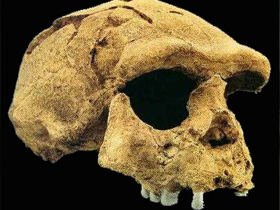In 1921, Dr. Davidson Black discovered two molar teeth in a depression near the village of Choukoutien, attached to the Chinese city of Pekin (Beijing). These two teeth were given the name Sinanthropus pekinensis and were suggested to belong to a hominid, or human-like creature. Dr. W.C. Pei found a third tooth in 1927, and several skull fragments and two pieces from the jaw in 1928. Black claimed that these belonged to S. pekinensis and announced that its skull volume was 900 cubic centimeters. Its age was estimated at 500,000 years.
In 1936 three skulls were discovered in the same place by Pei and the American Professor Franz Weidenreich. These skulls, too, were declared to belong to S. pekinensis, and the skull volume was enlarged to 1,200 cubic centimeters. Apart from the two molars, all the materials found as evidence disappeared between 1941 and 1945. All that remains is Weindenreich's plaster models of them.
Of most critical importance to an evaluation of this material is . . . that all of this material except two teeth disappeared sometime during the period 1941-1945, and none of it has ever been recovered. Many stories concerning the disappearance of this material have circulated, the most popular being that it was either lost or seized by the Japanese during an attempt to move it from Peking to a U.S. Marine detachment that was evacuating China. None of these stories has been verified. No living person apparently knows what happened to the material.
As a result, we are totally dependent on models and descriptions of this material left by a few investigators, all of whom were totally committed to the idea that man had evolved from animal ancestors. Even is a scientist is a completely objective as humanly possible, the model of description he fashions on the basis of scanty and incomplete material with reflect to a critical degree what he thinks the evidence ought to show. Furthermore, there is ample evidence that objectivity was seriously lacking in the treatment and evaluation of the material recovered at Choukoutien.
All we have available are the models fashioned by Weidenreich. How reliable are these models? Are they accurate casts of the originals, or do they reflect what Weidenreich thought they should look like? 180
Increasing discoveries in the years that followed, and particularly after the 1990s, made it clear that no such evolutionary process as the tree of descent, proposed by evolutionists, ever took place. In terms of their age, geographical regions and anatomical features, the fossils discovered could not be placed in any evolutionary sequence. Increasingly, therefore, the idea that Peking Man was to the missing link lost support, and evolutionists abandoned hope of having found any missing link.
. . . most of the participants at the Senckenberg conference got drawn into a flaming debate over the taxonomic status of Homo erectus started by Milford Wolpoff of the University of Michigan, Alan Thorne of the University of Canberra and their colleagues. They argued forcefully that Homo erectus had no validity as a species and should be eliminated altogether. (Pat Shipman, “Doubting Dmanisi”, American Scientist, November- December 2000, p. 491)
The latest developments with regard to H. erectus, under which Peking Man is classified, forced the National Geographic's TV channel to make an important admission. The program quoted the physical anthropologist Gary Sawyer of the American Museum of Natural History as saying that Peking Man, in terms of his physical characteristics, was a genuine human being. This retreat once again shows that the scenario of the human line of descent has collapsed. The crystal reality is that humans and apes are life forms created separately by Allah.
180. Gish, D. T., Evolution: The Fossils Say "No," San Diego: Creation-Life Publishers, 1979.


